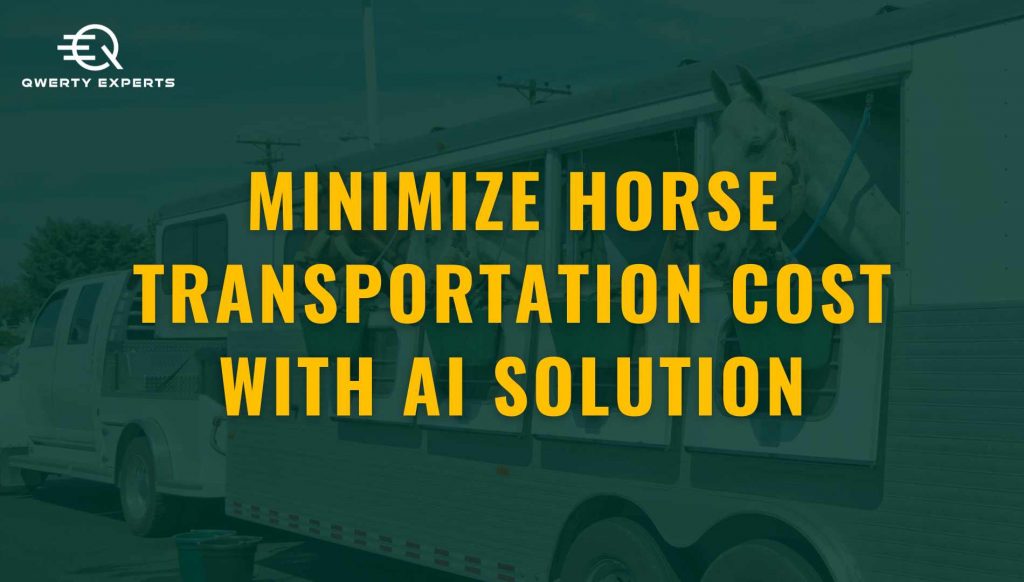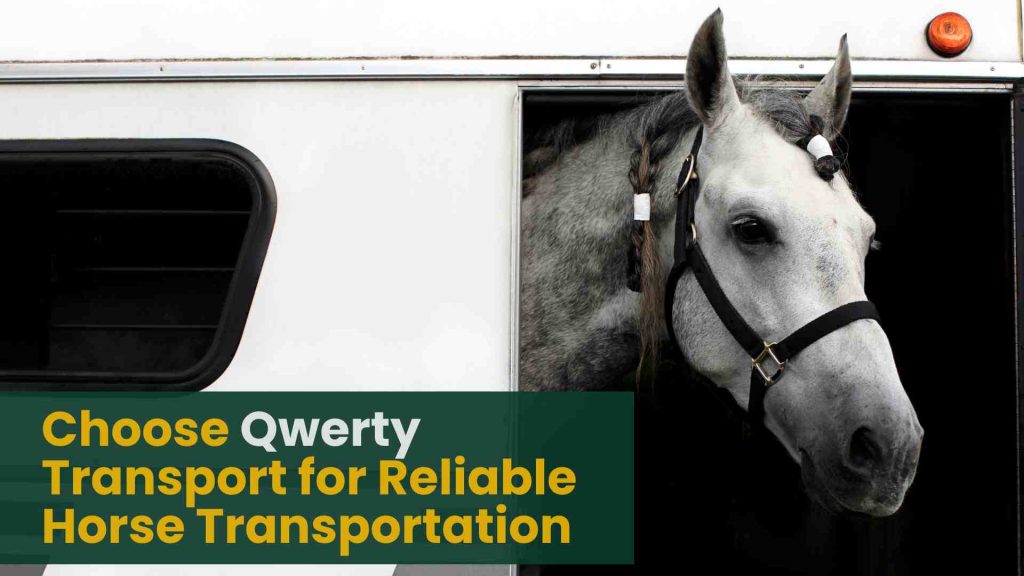
Moving your horse carefully is a major duty. Great care needs to be executed as a live animal before horse transport costs to guarantee that your animal’s transportation method is as stress-free and secure as it possibly can be. There are four ways of transportation to select from whether you are sending your horses across the nation or internationally for a contest or relocating: air, rail, road and sea.
Riding a horse comes with greater expenses. For a one-way ticket, flying a horse would set you back anything from $2,000 to $10,000. A return trip can run up to $20,000. Flying a horse is linked to several elements, including degrees of comfort, location, even additional veterinarian costs.
Table of Contents
Horse Transportation Costs
Horse transport cost could vary depending on distance, method of transportation, destination, health certificate and transporting records. Horse travel prices per mile fall between $0.75 and $3. The expense of moving a horse across the country might involve extra transit fees ranging from $150 to $300 daily. For your horse, the stopover fees pay all required costs for the travel and overnight stay.
The cost of flying a horse is higher. The cost of a one-way ticket to fly a horse can range from $2,000 to $10,000. The cost of returning transport can reach as high as $20,000. Traveling a horse requires consideration for the comfort level, the location, even extra veterinary charges.
Horse Transportation Cost by Air
To ship your horse via air is the most expensive alternative. You will have to deal with an organization that handles live animal air transportation. Flying is usually limited to international transportation instead of local since it can be uncomfortable for horses.
Horses are transported in dedicated cargo aircraft, typically kept in stalls. You, one of your groomsmen, or a transportation provider representative must accompany them throughout the trip. Your horse will be provided with food and water through their journey by someone who accompanies it.
The horse transportation cost by plane is determined by a number of factors, such as:
- Touring class:
Horses have many travel classes, just like people. Your horse can travel alone or in a stall with other horses, and there are stall sizes to choose from. - Travel class:
As with humans, horses have different travel classes. Different stall sizes available your horse can ride separately or with multiple horses in a stall. Top class, business class, and economy class are the three classes in which horse transport is typically classified. Depending on the class, costs differ. - Final destination:
The distance your horse is traveling will determine how much the trip will cost. The farther a flight is from its final location, the more expensive it gets. If there are any flight connections, the fees will also increase as your horse may need to be moved between planes. - Airport availability:
Horses cannot be transported by all airports or flights. If horses are not transported by your airport, a plane might have to be arranged to take your horse. It will be special with premium horse transport costs. As a backup, you could have to get your equine to the closest airport that flies equines.
Horse Transportation Cost by Road
Domestically, the most prevalent method of horse transporting is via road. Additionally, it is generally secure for horses and with typically less horse transportation cost than other options . Some of the factors that affect the cost per mile of transporting a horse include:
- Stopovers:
Stopping for layovers to horses is necessary when moving an extensive distance. This allows them to extend and exit the horse cage for a small period of time. You may also wish to locate a location where your horse can be stabled overnight, as opposed to leaving them in the trailer. - Number and Size:
The expense may be affected by the quantity and size of equine needed to be transported. Horses must be conveyed in a carriage that is appropriate for their size. The costs and the size of the carriage required increase as the number of horses to be transported increases. - Season:
The cost of transportation of a horse during wintertime can be higher due to the potential for closed roads caused by extreme weather. This leads to higher expenses by extending the transportation path.
Horse Transportation Cost by Rail
Rail is an additional method of domestic equine transportation If your voyage commences and concludes near a railway station or you have a number of days to travel, rail transport may be a viable alternative. Transporting horses through rail is one of the best routes, as it contains no sharp shifts in path, smooth roads, or quick pauses.
Motion sickness in equines may be avoided by providing them with a more secure and comfortable trip. Although traveling by trains, horses might be able to sleep, which may facilitate their recovery from the journey.
Horse Transportation Cost by Sea
Shipment of a horse by water is frequently employed as the final option when the other three alternatives are unavailable. The journey can be lengthy, and delays may increase the duration. Due to shifting sea conditions, horses can get seasick like humans. Horses are incapable of vomiting, with the exception of certain severe circumstances. A potentially life-threatening condition, colic, may result from their seasickness and inability to defecate.
The transportation of a horse internationally entails a variety of procedures, each of which will have massive expenses. The following is a concise guide to assist you in estimating the cost
7 Ways AI Helps Lower Costs in Horse Transportation
Transporting horses can be complex and costly, with factors like fuel prices, unpredictable road conditions, and vehicle maintenance impacting the bottom line. But did you know AI (artificial intelligence) can help lower these costs? Here’s how integrating AI into horse transportation can make the process smoother, more efficient, and cost-effective.
1. Smarter Route Planning
One of the biggest expenses in transportation is fuel, especially with horses, where longer routes can mean higher costs and more travel stress. AI can optimize routes by analyzing real-time data on traffic, road conditions, and weather. This means drivers take the shortest, safest, and most efficient routes saving time, and money, and ensuring the horses have a smoother ride.
2. Maximizing Space for Fewer Trips
Every trip counts when transporting horses. AI can help figure out how to arrange each load to fit the maximum number of horses safely in one go. Fewer trips mean less fuel, less wear and tear on vehicles, and reduced costs overall. So, not only does the trip become more economical, but it’s also better for the environment!
3. Predictive Maintenance for Reliable Vehicles
Breakdowns on the road are not only stressful but also costly. AI-driven maintenance can predict when a vehicle needs repairs before something goes wrong. By keeping vehicles in peak condition, AI helps avoid those unexpected repair costs and ensures reliable trips, making the journey safer for both horses and drivers.
4. Efficient Resource Management
Horse transportation demand can vary based on the season or event schedules, which affects resource allocation. AI can analyze patterns in demand, so companies know when they need more (or fewer) drivers and vehicles on standby. This ensures resources are used only when needed, keeping costs low during quieter times.
5. Fuel Tracking and Management
AI can track fuel consumption in real-time, offering insights into how to improve fuel efficiency. For example, it can suggest ways to reduce idle time or give drivers tips for more fuel-efficient driving. Over time, these little tweaks can add up to significant savings!
6. Dynamic Pricing Based on Demand
AI can also help companies set fair and competitive prices based on demand, capacity, and seasonal trends. This way, customers get a fair price for transportation services without unexpected spikes.
7. Reducing Risks and Avoiding Extra Costs
From unexpected weather to roadblocks, horse transportation comes with risks. AI can evaluate risks in real time, helping drivers avoid delays and keeping the transportation process smooth and hassle-free.
Shipment Process of a Horse Abroad
The transportation of a horse internationally entails a variety of procedures, each of which will have massive expenses. The following is a concise guide to assist you in estimating the horse transport cost.
Isolation
Approximately $1,000 to $3,000 is required for transporting horses to a USDA-approved location and quarantining them for 30 days prior to transportation.
Bloodwork and vaccinations
Moving abroad a horse demands extra examinations, as it needs to pass a Coggins testing to determine whether it has antibodies against Equine Infectious Anemia (EIA). Depending on the horse’s age, gender, and other health concerns, the cost of this procedure is approximately $1,000 to $3,000 and should be performed by a USDA-approved veterinarian.
Preboarding
Your horse will be transported to the airport prior to boarding the flight, where it will be subjected to an additional five hours of quarantine. The cost will be significantly influenced by the distance between the isolation facility and the airport.
The Flight
You are required to load your horse into a container that has been approved and inspected for the duration of the voyage. You can rent a container for approximately $1,500. It would be advantageous to have an attendant accompany your horse, as it is incapable of traveling independently. The cost of shipping can vary from $3,000 to $10,000 or more, contingent upon the destination and the airline you select.
Therefore, that is the process that your horse must undergo prior to being exported to other countries. Nevertheless, as previously mentioned, it is crucial to execute the procedure accurately in order to prevent any negative consequences for the horse’s health. To guarantee the safe arrival of your horse, it is recommended that you observe the following guidelines.
Local Versus International Horse Transport Cost
Requirements:
Generally, it is more cost-effective to transport your horse locally, as it can be done via road. The specific medical documentation required from an accredited veterinarian will vary depending on whether the horse is being transported domestically for competitions, auctions, or relocation. Proof of vaccination for the Equine Influenza Virus and Equine Herpes Virus and a Coggins test are mandatory for the majority of horse competitions in the United States at least six months prior to the event.
Documentation
To convey a horse to an auction, it may be necessary to possess a Certificate of Veterinary Inspection. These certificates demonstrate that your horse is disease-free and are typically valid for 30 days, contingent upon the state or region’s disease situation. The necessary documentation is contingent upon whether you are traveling within or outside of your state. Regional policies may vary among countries; therefore, it is imperative to verify them.
Overseas Horse Transportation Fees
When transporting your horse overseas, there are also additional fees. Typically, it is necessary to sequester your horse prior to departing the country. for a period of up to 30 days, they will be required to be transported to a facility that has been approved by the United States Department of Agriculture (USDA). The cost of this product could vary between $1,000 and $3,000. You will also be required to undergo a valid Coggins test by a USDA-approved veterinarian, which will incur a cost of $1,000 to $3,000.
Quarantine and Import Requirements
Pre-boarding quarantines may extend for up to five hours on certain flights. This expense will be contingent upon the isolation facility’s distance from the airport. In addition to the cost of shipping your horse, the destination country may also have additional vaccination and isolation requirements upon arrival.
The quarantine requirements will determine the cost of importing a horse into the United States. Horses are subject to quarantine requirements that are determined by the country of origin, the reason for their entry into the country, and the disease status of the country.
Experience Reliable Horse Transportation with Qwerty Transport

Transporting your horse requires attention, experience, and care. At Qwerty Transport, we understand the all needs for equine transportation and work with you every step of the way to ensure your horse’s safe and efficient journey. Our dedicated team specializes in handling and planning for horse transport, make sure that your horse is treated with the utmost respect and care throughout the entire process.
Our horse transportation services include comprehensive planning, regulatory compliance, and specialized handling to ensure safety and comfort. From quarantine and isolation services to veterinary health checks and certification, we cover every detail necessary for smooth, reliable horse transport. Whether it’s across town or the country, we’re committed to providing a secure and comfortable journey for your horse.
Request a quote today to experience the Qwerty Transport difference in horse transportation!






